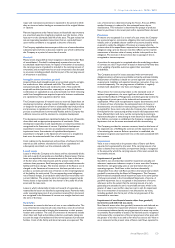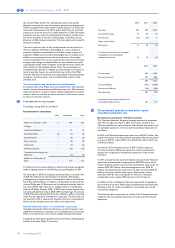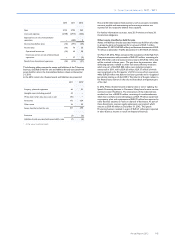Philips 2012 Annual Report Download - page 136
Download and view the complete annual report
Please find page 136 of the 2012 Philips annual report below. You can navigate through the pages in the report by either clicking on the pages listed below, or by using the keyword search tool below to find specific information within the annual report.
12 Group financial statements 12.10 - 12.10
136 Annual Report 2012
presented. A discontinued operation is a component of the Company,
which comprises operations and cash flows that can be distinguished
clearly, both operationally and for financial reporting purposes, from
the rest of the Company. A component that previously was held for
use will have been one or more cash-generating units. Generally, the
disposal of a business that previously was part of a single cash-
generating unit does not qualify as a component of an entity and
therefore shall not be classified as a discontinued operation if disposed
of.
Comparatives in the balance sheet are not re-presented when a non-
current asset or disposal group is classified as held for sale.
Comparatives are restated for presentation of discontinued operations
in the Statement of cash flow and Statement of income.
Upon classification of a disposal group as held for sale the Company
may agree with the buyer to retain certain assets and liabilities (e.g.
accounts receivable), in which case such items are not presented as part
of assets/liabilities held for sale, even though the associated item in the
Statement of Income would be presented as part of discontinued
operations. The presentation of cash flows relating to such items in that
case mirrors the classification in the Statement of Income, i.e. as cash
flows from discontinued operations.
Adjustments in the current period to amounts previously presented in
discontinued operations that are directly related to the disposal of a
discontinued operation in a prior period are classified separately in
discontinued operations. Circumstances to which these adjustments
may relate include resolution of uncertainties that arise from the terms
of the disposal transaction, such as the resolution of a purchase price
adjustments and indemnifications, resolution of uncertainties that arise
from and are directly related to the operations of the component
before its disposal, such as environmental and product warranty
obligations retained by the Company, or the settlement of employee
benefit plan obligations provided that the settlement is directly related
to the disposal transaction.
Segments
Operating segments are components of the Company’s business
activities about which separate financial information is available that is
evaluated regularly by the chief operating decision maker (the Board of
Management of the Company). The Board of Management decides how
to allocate resources and assesses performance. Reportable segments
comprise the operating sectors: Healthcare, Consumer Lifestyle,
Lighting, and, until 2011, the Television business which was part of
Consumer Lifestyle. Segment accounting policies are the same as the
accounting policies as applied to the Group. Segment reporting
comparatives are reclassified for profit or loss purposes, so it is no
longer mentioned for the Television business. The previously reported
segment GM&S (Group, Management & Services) has been renamed
IG&S (Innovation, Group & Services). This change did not affect the
description and the financial information reported under this segment.
Please refer to section 12.9 for details.
Cash flow statements
Cash flow statements are prepared using the indirect method. Cash
flows in foreign currencies have been translated into euros using the
weighted average rates of exchange for the periods involved. Cash
flows from derivative instruments that are accounted for as fair value
hedges or cash flow hedges are classified in the same category as the
cash flows from the hedged items. Cash flows from other derivative
instruments are classified consistent with the nature of the instrument.
Earnings per share
The Company presents basic and diluted earnings per share (EPS) data
for its common shares. Basic EPS is calculated by dividing the net income
attributable to shareholders of the Company by the weighted average
number of common shares outstanding during the period, adjusted for
own shares held. Diluted EPS is determined by adjusting the Statement
of income attributable to shareholders and the weighted average
number of common shares outstanding, adjusted for own shares held,
for the effects of all dilutive potential common shares, which comprise
convertible personnel debentures, restricted shares and share options
granted to employees.
Financial guarantees
The Company recognizes a liability at the fair value of the obligation at
the inception of a financial guarantee contract. The guarantee is
subsequently measured at the higher of the best estimate of the
obligation or the amount initially recognized.
Accounting changes
In the absence of explicit transition requirements for new accounting
pronouncements, the Company accounts for any change in accounting
principle retrospectively.
IFRS accounting standards and voluntary accounting policy
changes adopted as from 2012
The accounting policies set out above have been applied consistently
to all periods presented in these Consolidated financial statements
except as explained below which addresses changes in accounting
policies.
The Company has adopted the following new and amended IFRSs as of
January 1, 2012.
IFRS 7 Financial Instruments: Disclosures - Transfer of
financial assets
According to this amendment, disclosures are required for financial
assets that are derecognized in their entirety and where the entity has
continuing ‘involvement’ in them. The amendment was adopted by the
Company on January 1, 2012 and impacted disclosures only.
Voluntary changes
The Company has also adopted a number of voluntary accounting policy
changes on January 1, 2012. The accounting policy changes have no
impact on Earnings per share, the Consolidated balance sheets,
Consolidated statements of cash flows and Consolidated statement of
changes in equity.
• Warranty costs previously reported in Selling expenses have been
reclassified to Cost of Sales. The reason for this change follows the
rationale that warranty expenses are an integral part of the sale of
goods and services. The amount included in Cost of Sales in 2012 is
EUR 280 million. This policy change has been applied retrospectively
and reduced Selling expenses and increased Cost of sales as follows
for 2010 and 2011:
2010 2011
Statements of income
Cost of sales (325) (328)
Selling expenses 325 328
• Amortization of brand name and customer relationship intangible
assets previously reported in Cost of sales in the Statements of
income has been reclassified to Selling expenses. The reclassification
follows the rationale that the use of brand names and customer
relationship intangible assets supports the sales process. The amount
included in Selling expenses in 2012 is EUR 342 million. This policy
change has been applied retrospectively and resulted in a
reclassification from Cost of sales to Selling expenses as follows for
2010 and 2011:
2010 2011
Statements of income
Cost of sales 257 415
Selling expenses (257) (415)
• The third change relates to the intellectual property (IP) policy. IP
royalties on products sold by a sector are allocated to that sector.
IP royalties related to products, which are no longer sold by a sector,
were allocated to Group Management & Services (currently
Innovation, Group & Services), with the exception of sector
Consumer Lifestyle, where IP royalties on such products were
allocated to the sector Consumer Lifestyle itself. As of 2012, all IP
royalties on products no longer sold by a sector have been allocated
to the sector Innovation, Group & Services (IG&S) to ensure
consistency, and the exception for Consumer Lifestyle IP royalties
has been abolished. This policy change is applied retrospectively and
only impacts the sector information (section 12.9), resulting in a
reclassification on the Sales and Income from operations
respectively from the sector Consumer Lifestyle to the sector IG&S.
This change also has reclassification impacts on the Total assets of
sector Consumer Lifestyle and sector IG&S as shown in the sector
information (section 12.9). As of 2012, IP royalties have been
integrated in the IG&S sector. The reclassifications have been
included in the table below.
























